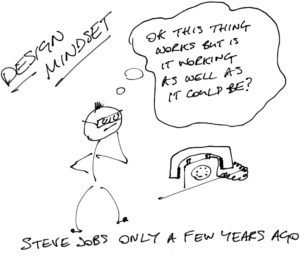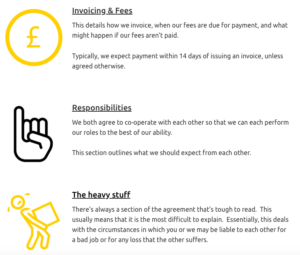Everyone has some idea of what a designer looks like. Sharply dressed with an edgy pair of glasses. Types fast on a MacBook Air. Occasionally does a spin on an ergonomic yet stylish chair. Designers are cool. And they are bringing all their coolness – their edge, imagination, and more importantly, their innovative thinking – to the world of law. Time to sit up.
legal design.
What are we talking about? Legal design. The newest disruptive force in the legal industry.

Erm, ok, you’re thinking. What are we designing, exactly? Trendier robes and wigs for barristers? Ways to deliver a court summons via app? Surely anyone can put information into a snazzy PowerPoint complete with sound effects? “I’m pretty good at using Microsoft Paint myself”, you might say.
In fact, legal design is about much more than choosing a cool font. It’s a mindset, culture, and way of life. It’s about taking design thinking and applying it to the legal industry.
but what is design thinking?
“Design is about usability, it is about utility, and it is about engagement.” (Margaret Hagan – Law by Design)
In short, design thinking is about putting the user first.
Designers take advantage of user research to make the user experience more engaging. They identify people’s needs and create solutions. How might they make human lives easier and more enjoyable? How might they add value to our day-to-day living?

Design thinking is all about asking “how might we do this better?”
Designers first aim to understand what the user needs: this means focus groups, surveys, design workshops, and statistical analysis. Then they research all aspects of the problem. They might even set up hackathons or design jams to brainstorm ideas. Then they begin to solve the issue, trying out different possibilities, taking on board feedback, adapting, and improving.
The user is often one step removed from the client. A lawyer might be writing a contract for a bank. The “user” of the contracts is not necessarily the client (the bank). It might be the bank’s customers. A designer would try to understand the impact of its design on the customer. A lawyer would tend to understand the impact of the contract on the client.
Designers do not work alone. They collaborate with other disciplines, working together with psychologists, coders, researchers, and behavioural scientists, to profit from diverse expertise and perspectives. This diversity of thought helps designers to come up with more innovative solutions.
so how does design thinking apply to law?
It means an approach to law that is creative, collaborative, and leads to the law being delivered in a different way.
It means creating a user experience that is intuitive, attention-grabbing, and satisfying. Because when things are engaging and enjoyable, they become a valued part of people’s lives. And isn’t that what we’d like for law too?
Applying design thinking to the world of law might result in a new way of communicating information. A way that is functional and aesthetically pleasing.
Or it might lead to the implementation of a whole new service or product, such as an improved digital interface for people to navigate a specific part of the legal system.
It might result in an innovative way of carrying out processes with the organisation, helping people to collaborate more effectively and efficiently. Essentially, legal design means thinking outside the box. Yep, that old chestnut.
One obvious way in which legal designers can improve legal services is by turning legal documents into something people can actually read.
In general, contracts are drafted by lawyers for lawyers. The result? Something that looks like War & Peace written backwards.
Who actually checks ‘Terms & Conditions’? Privacy policies? Company compliance procedures? We are turning our users off with language they don’t understand, and which furthermore is presented in an unengaging way.
Remember the General Data Protection Regulation mandate that came out in 2018? The one that demanded that all privacy notices be concise, transparent and written in plain language? How many companies have taken notice of that warning?
step forth legal design.
Legal design bridges the gap between lawyers and the people interacting with what they produce. Legal design can simplify legal documents and make them comprehensible. It can help lawyers to communicate difficult concepts in a way that is inclusive and accessible. We’re talking concise summaries, headings, highlighting, cool typefaces, flowcharts, coloured icons, diagrams, and timelines. Nice visuals to make complex ideas tangible and easy to grasp.
 Take the ‘Terms & Conditions’ page at the end of an online shopping experience, for example. You’re all ready to check out and then suddenly there’s this 25-page document about your rights as a consumer.
Take the ‘Terms & Conditions’ page at the end of an online shopping experience, for example. You’re all ready to check out and then suddenly there’s this 25-page document about your rights as a consumer.
Legal design thinking can transform this experience into a transparent and empowering exchange by making ‘Terms & Conditions’ pages easy to understand and maybe even enjoyable (*gasp*) to read. It can use the appropriate brand voice, boosting the overall brand story, and demonstrate that you care about your customers’ rights.
the future for legal design.
The legal design movement is making strides across the globe.
At Stanford Law School, the Legal Design Lab is an interdisciplinary venture that aims to train law students and professionals in legal design. Across the world fellow legal designers are doing what they can to make sure that the concept takes hold with workshops and legal design sprints. For the same reason, we offer legal design workshops in the UK.
Ultimately there needs to be a paradigm shift in how lawyers think. Law needs to become more creative, collaborative, innovative, and understanding. A view shared by many and reinforced by Margaret Hagan, from the Legal Design Lab, in this powerful statement;